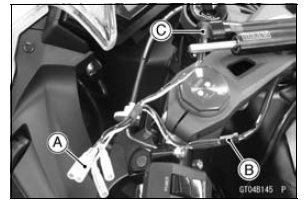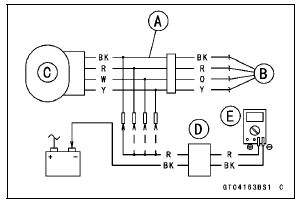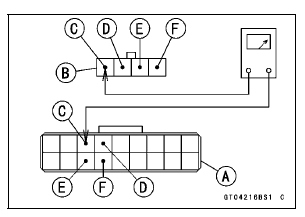

NOTE
Be sure the battery is fully charged.

Main Harness [B] ESD Actuator [C]
Special Tool - Peak Voltage Adapter: 57001-1415 Type: KEK-54-9-B

ESD Actuator Input Voltage Connections to Adapter:
(I) Digital Meter (+) → BK (actuator BK) lead Digital Meter (–) → Battery (–) terminal (II) Digital Meter (+) → R (actuator R) lead Digital Meter (–) → Battery (–) terminal (III) Digital Meter (+) → W (actuator O) lead Digital Meter (–) → Battery (–) terminal (IV) Digital Meter (+) → Y (actuator Y) lead Digital Meter (–) → Battery (–) terminal
Input Voltage
Standard: About DC 9  11 V and then
11 V and then
0.1 V or
About DC 9  11 V
11 V
If the reading is out of the specification, remove the ESD ECU and check the wiring for continuity between main harness connector.
Special Tool - Hand Tester: 57001-1394
Disconnect the ESD ECU and actuator connectors.

Wiring Continuity Inspection ESD ECU Connector [A] ←→ ESD Actuator Connector [B] BK lead (ESD ECU terminal 3) [C] R lead (ESD ECU terminal 4) [D] O lead (ESD ECU terminal 12) [E] Y lead (ESD ECU terminal 13) [F]
If the wiring is good, check the ESD ECU for its ground and power supply (see ESD ECU Power Supply Inspection).
If the ground and power supply are good, replace the ESD ECU (see ESD (Electronic Steering Damper) ECU Removal/ Installation in the Steering chapter).
ESD Actuator Circuit

1. ESD ECU
2. ESD Actuator
 ESD Actuator Resistance Inspection
ESD Actuator Resistance Inspection ESD (Electronic Steering Damper) ECU Error (Service Code E3b, ZX1000JD/KD)
ESD (Electronic Steering Damper) ECU Error (Service Code E3b, ZX1000JD/KD)Overview
S-KTRC is a highly sophisticated system based on MotoGP racing technology.
Unlike the KTRC
system used on the GTR1400 ABS (Concours 14 ABS in N. America), which is
designed to offer rider
reassurance when traversing slippery surfaces, S-KTRC, is designed to maximize
forward motion,
allowing ...
License Plate Light Bulb Replacement
Remove:
Screws [A]
License Plate Light Cover [B]
Pull the bulb [A] out of the socket [B].
NOTICE
Do not turn the bulb. Pull the bulb out to prevent
damage to the bulb. Do not use bulb rated for
greater wattage than the specified value.
Replace the bulb with a new one.
In ...
Air Switching Valve (Service Code 64)
Air Switching Valve Removal/Installation
Refer to the Air Switching Valve Removal/Installation in
the Engine Top End chapter.
Air Switching Valve Inspection
Refer to the Air Switching Valve Unit Test in the Electrical
System chapter.
If the air switching valve [A] is normal, check ...